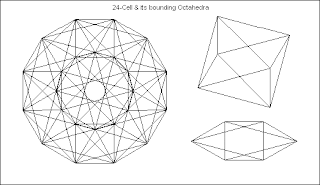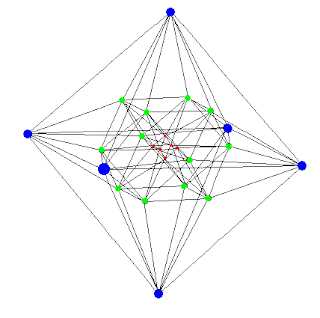This model, which is still in its early Evolution, is the result of a synthesis many different streams of information that are resurfacing in this age of information explosion. Some of these sources are fairly obscure, but currently resurfacing as a result of the Times we live in. Nonetheless, I believe there is potential to make this a very elegant, simple, working model with applications from computers to chemistry. I will be taking time later to flesh out the various ideas presented and how they correlate.

These numbers are formed from the Fibonacci series, a sequence of whole numbers which increasingly approximate the Golden Ratio. Using Marko Rodin's Vortex-Based Mathematics (http://markorodin.com/1.5/), we add up the Fibonacci numbers into single digits, and a very clear pattern emerges. The numbers occur in a repetitive cycle of 24, which can be arranged around a circle, where one who is familiar with Rodin numbers immediately will notice the patterns.

These numbers are formed from the Fibonacci series, a sequence of whole numbers which increasingly approximate the Golden Ratio. Using Marko Rodin's Vortex-Based Mathematics (http://markorodin.com/1.5/), we add up the Fibonacci numbers into single digits, and a very clear pattern emerges. The numbers occur in a repetitive cycle of 24, which can be arranged around a circle, where one who is familiar with Rodin numbers immediately will notice the patterns.
Notice the 9 at each node, which are points of two 3-6-9 triangles moving clockwise and counter-clockwise. Notice also how each number added to the number directly across from it is equal to 9. Thus the cycle can also be looked at as a sine wave with 9 at zero, and the two sides of the circle as mirror inverses of each other. The other triangles formed are the 1-4-7 and 2-5-8 families going both clockwise and counter-clockwise, and a 1-1-1 triangle and 8-8-8 triangle. More on this as it relates to crystallization later.
John DePew at Coral Castle Code http://www.coralcastlecode.com/ has shown how Edward Leedskalnin left behind a code pertaining to his flywheel, composed of 24 magnets around a circle, and a pattern behind primes and prime quadruplets built off of this template. Note also how important the number 144 is in this system, which is the first 9 which appears in the Fibonacci series as well as the first square number after 1.
Garrett Lisi, is a surfer who has shocked the world of particle physics with a rotational model of the E8, a hyperdimensional geometric figure which supposedly models accurately all the particles in physics http://garrettlisi.com/. His work was based in part on the work of El Naschie, who used Golden Ratio to model self-similarity in particles http://www.el-naschie.net/. Look at this view of the E8 which fits onto the 24-numbered circle.
Russell's cosmology describes a Universe where nine amorphous inert gases project concept into form, climaxing in carbon, which has the highest melting point of any element, which dissolves back into space where its memory is preserved in the inert gases. When compared the Rodin Fibonacci numbers around the circle the correspondence is clear. The 1 and 8 which lie along the perpendicular line from the two 9s suggests the Law of Octaves, and perfect cubic crystallization (diamond) which occurs at the peak of the wave. Note also that the cube of any whole number added up to a single digit will always be 1,8, or 9.
The 24-cell is a unique polytope in hyper-dimensional geometry arranged of 24 octahedral cells. Just as there are five platonic solids in 3 dimensions, there are six regular figures or polytopes in 4 dimensions, one corresponding to each platonic solid, and then the 24-cell. It is capable of nesting all the platonic solids, as well as the other 4-d regular polytopes, as well as the 3 regular polytopes in 5 and 6 dimensions. Thus the 24-cell seems to be a master key to regular geometric figures, which are used by nature as symmetry sets for building order upon.
The arrangement of the cells in a 24-cell can be viewed as a central octahedron nested inside a cubeoctahedron, nested inside a larger octahedral envelope, however the figure can be rotated through a 4th dimension such that any cell can be in the center, or be the envelope containing the other three.
It can rotate through itself while maintaining perfect symmetry and compression. This fluctuation between octahedron and cuboctahedron can be very easily pictured as Buckminster Fuller's vector flexor "jitterbug". Note how it passes through the icosahedron (based on golden ratio) in between these two states.
http://www.youtube.com/watch?v=FfViCWntbDQ I would be very interested if anyone could model Nassim Haramein's http://theresonanceproject.org vector equilibrium 64-tetrahedron matrix pictured below. going through this jitterbug dance.
Thus we see the possibility of producing a template, which can tie together a multitude of fundamental concepts including; numbers and the basic pattern contained therein revolving around the number nine, the law of octaves, the golden ratio and fibonacci series, prime numbers, fundamental geometry, particle physics, the periodic table of elements, the law of crystallization, astronomy, the structure of time, DNA, and multiple systems of esoteric wisdom.
As the increase in information accelerates, it will become necessary to have a more efficient way of processing and storing that information. This embedding of information is the origin of symbol as shown by Dan Winter, http://www.goldenmean.info/dnaring and I believe this template can be a key to both the internal and external technology that allows us to order all things.
I would encourage anyone who is interested in this material to develop artistic representations of this template. It is quite clear that this information does not belong to anyone and can be represented in infinitely creative media.






Very good work. What we need to do now is to make it a workable science. We need to connect this model to equations in Engineering and Physics. Dan Winter has managed to make some of the important details. Energy is a common variable here. In Engineering, Energy in Physics description is the foundation of all its equations.
ReplyDeletevery nice blog... i'm glad you mentioned the 147, 258s.. but it's important that you mention all 3 equilateral triangles points are always separated by 3s (flaunts the perfection)
ReplyDeletei've mentioned these 3 specific degrees before;
1st degree: 1 to 4, 4 to 7, 7 to 1
2nd degree: 2 to 5, 5 to 8, 8 to 2
3rd degree: 3 to 6, 6 to 9, 9 to 3
Also, review the multiplication table which points out the 3, 6, 9s in columns and the obvious inverts:
ReplyDeleteexample of 3s, following 369:
1x3=3,
2x3=6,
3x3=9,
6s follow 639:
6x1=6,
6x2=3,
6x3=9,
9s always follow 999. so you can simply explain that X*9 =9 regardless.
*123456789
1123456789
2246813579
3369369369
4483726159
5516273849
6639639639
7753186429
8876543219
9999999999
our 3 paired inverts are 1 + 8, 2 + 7, 4 + 5 (which yes, happen to equal 9 and create a HEX.)
1 is the invert of 8, therefore;
mult. of 1: 123456789 in mult. 8 is 987654321
2 is the invert of 7, therefore;
mult. of 2: 246813579 in mult. 7 is 975318642
and finally...
4 is the invert of 5, therefore;
x4: 483726159 = invert x5: 951627384
24-cell
ReplyDeletehttp://nevredim.ucoz.ru/
https://sites.google.com/site/sekretycivilizacii2/
ReplyDeleteInteresting. But you used my copyrighted image of the double spiral within the E8 projection without attribution. This was an original discovery and was published here: http://wizardgynoid.wordpress.com/2009/05/06/new-double-spiral-into-the-heart-of-the-e8/ You have my permission to use it as long as you attribute it properly.
ReplyDeleteFantastic! I've been looking for how the golden ratio interacts with the Vector Equilibrium (VE). I've modeled all of this geometry and have noticed many other ratios not mentioned in this blog, such as sqrt(3), sqrt(2), sqrt(5), all associated with distances between faces and/or distances between vertices as the geometry morphs through this cycle.
ReplyDeleteI have not yet found the sqrt(7), the only remaining one (the sqrt's of 4,6,8,9 of course are all subsets of sqrt's of 2 and 3). It's interesting that you also mention cube roots, I haven't considered this.
I'd be happy to share the study, but not sure how to enclose here.
I loved your post. Much obliged. advancecalculators
ReplyDelete